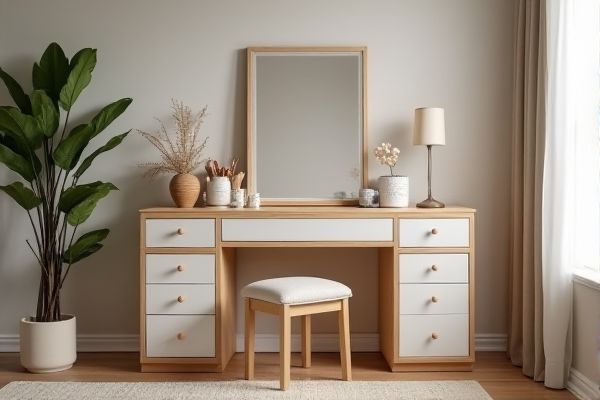
Vanity tables are designed primarily for makeup application and feature a mirror and storage specifically for cosmetics, while dressing tables offer a broader setup with more storage for clothing and accessories. Discover which table best suits your personal space and daily routine by reading the rest of the article.
Table of Comparison
| Feature | Vanity Table | Dressing Table |
|---|---|---|
| Primary Use | Makeup application, personal grooming | Clothing storage, dressing, grooming |
| Design | Compact, includes mirror and storage for cosmetics | Larger, often with drawers and wider surface for clothes |
| Storage | Small compartments for makeup and accessories | Multiple drawers for clothes and accessories |
| Mirror | Integral mirror, often illuminated | Attached or separate mirror, not always illuminated |
| Typical Location | Bedroom or dressing room | Bedroom, dressing room, or walk-in closet |
| Style | Elegant, often vintage or modern | Functional, versatile in styles |
| Price Range | Moderate to high, depending on design and features | Varies widely, often affordable to premium |
Introduction: Vanity Table vs Dressing Table
Vanity tables primarily emphasize personal grooming with features like mirrors, built-in lighting, and compartments for cosmetics and beauty tools, optimizing daily makeup routines. Dressing tables generally serve broader purposes, including storage for clothing accessories and as a functional surface for getting dressed, often lacking integrated mirrors or specialized lighting. Choosing between a vanity table and a dressing table depends on the specific needs for beauty organization versus multifunctional dressing convenience.
Defining a Vanity Table
A vanity table is a dedicated piece of furniture designed primarily for personal grooming and makeup application, featuring a mirror and specialized compartments for cosmetics and accessories. Unlike a general dressing table, a vanity table often includes integrated lighting to enhance visibility during beauty routines. Your choice depends on prioritizing functionality tailored to makeup storage and detailed grooming tasks.
What is a Dressing Table?
A dressing table is a functional piece of bedroom furniture designed primarily for personal grooming and storage, featuring a mirror, drawers, and a flat surface for cosmetics and accessories. Unlike a vanity table, which often emphasizes luxury and decorative appeal, a dressing table prioritizes practicality and organization to streamline your daily routine. This essential item helps keep your beauty essentials neatly arranged while providing a dedicated space for dressing and self-care.
Key Differences Between Vanity and Dressing Tables
Vanity tables typically feature a mirror and storage compartments designed for makeup and beauty products, emphasizing personal grooming, while dressing tables focus on providing ample surface area and drawer space for clothing accessories and daily use. Vanity tables often include built-in lights and specialized organizers, catering to detailed cosmetic routines, whereas dressing tables prioritize versatility and broader storage to accommodate various dressing needs. The distinction lies in their primary function: vanities center on makeup application, while dressing tables serve as multifunctional furniture pieces for dressing and storage.
Design and Aesthetic Features
Vanity tables prioritize elegance and functionality with integrated mirrors, storage for beauty products, and often feature delicate, feminine designs incorporating soft colors and ornate details. Dressing tables, designed primarily for wardrobe organization, emphasize spacious surfaces and larger storage compartments, frequently showcasing classic or vintage styles with robust wood finishes. Both pieces serve aesthetic purposes, but vanities create a dedicated beauty station, while dressing tables blend practicality with traditional bedroom decor.
Storage and Functionality Comparison
Vanity tables typically offer specialized storage options including compartments for makeup, jewelry, and personal grooming tools, making them ideal for beauty and skincare routines. Dressing tables often provide broader storage solutions with drawers and surface space to accommodate clothing accessories, mirrors, and decorative items, enhancing overall room organization. Your choice depends on whether you prioritize targeted beauty storage or versatile functionality for daily dressing needs.
Ideal Room Placement and Usage
Vanity tables are best placed in well-lit areas near windows or under bright artificial lighting to facilitate makeup application and grooming, while dressing tables suit bedrooms or closets where clothes and accessories are stored for easy outfit coordination. Vanity tables often feature mirrors and built-in lighting, enhancing detailed beauty routines, whereas dressing tables prioritize storage with drawers and surfaces for organizing clothing-related items. Both benefit from proximity to power outlets for electric beauty tools, but vanity tables emphasize accessibility to light sources, whereas dressing tables focus on convenience for dressing and wardrobe management.
Material and Style Options
Vanity tables often feature sleek glass, mirrored surfaces, and lacquered wood, emphasizing a modern and glamorous aesthetic, while dressing tables typically use solid wood or vintage finishes that highlight classic or rustic styles. Your choice may depend on the desired ambiance: vanity tables complement chic bedrooms with minimalist or contemporary decor, whereas dressing tables suit traditional or shabby chic interiors. Both offer versatile material and style options to match your personal taste and functional needs.
How to Choose the Right Table for Your Needs
When choosing between a vanity table and a dressing table, consider your primary use: a vanity table typically features a mirror and storage for cosmetics, making it ideal for makeup application, while a dressing table offers more space for organizing clothing and accessories. Assess the size of your room and available space; vanity tables are often more compact, perfect for smaller areas, whereas dressing tables tend to be larger with additional drawers or compartments. Your lifestyle and daily routine will guide the decision--if your focus is beauty and grooming, a vanity table suits your needs best, but for a multifunctional setup including outfit preparation, a dressing table provides greater versatility.
Conclusion: Vanity Table or Dressing Table?
Vanity tables typically feature a mirror and are designed for makeup application and grooming, while dressing tables prioritize storage and organization of clothing and accessories. Your choice depends on whether you need a dedicated space for beauty routines or a versatile area for wardrobe management. Selecting the right table enhances functionality and complements your bedroom aesthetics effectively.
 homyna.com
homyna.com